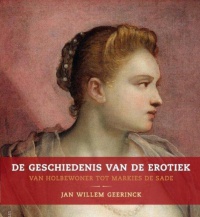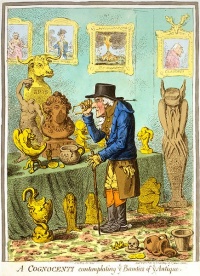Erotica timeline
From The Art and Popular Culture Encyclopedia


|
Related e |
|
Featured: |
This page traces the roots of modern erotica (themes, people, media) since its beginnings in Antiquity. It also includes historians and theorists of sexuality and erotica such as Sigmund Freud, Havelock Ellis, Wilhelm Reich, Michel Foucault, etc, influential in the history of sexology.
Contents |
Prehistory
- prehistory, prehistoric art, prehistoric erotica, primitive promiscuity, fertility rite, prehistoric religion, animal sexual behaviour
Among the oldest surviving examples of erotic depictions are Paleolithic cave paintings and carvings. Some of the more common images are of animals, hunting scenes and depictions of human genitalia (thought to be fertility symbols). Nude human beings with exaggerated sexual characteristics are depicted in some Paleolithic paintings and artifacts (e.g. Venus figurines). Recently discovered cave art at Creswell Crags in England, thought to be more than 12,000 years old, includes some symbols that may be stylized versions of female genitalia. However there is no indication that these were made for erotic stimulation, so it is far more likely that these were objects used in religious rituals. Archaeologists in Germany reported in April 2005 that they had found what they believe is a 7,200-year-old scene depicting a male figurine bending over a female figurine in a manner suggestive of sexual intercourse. The male figure has been named Adonis von Zschernitz. However, it is not certain that the purpose of these artifacts was individual sexual arousal. Instead, the images may have had a spiritual significance and are probably connected with fertility rituals.
Ancient history
Among the oldest surviving examples of erotic depictions are Paleolithic cave paintings and carvings, but many cultures have created erotic art. The ancient Greeks painted sexual scenes on their ceramics, many of them famous for being some of the earliest depictions of same-sex relations and pederasty, and there are numerous sexually explicit paintings on the walls of ruined Roman buildings in Pompeii. The Moche of Peru in South America are another ancient people that sculpted explicit scenes of sex into their pottery.
The Milesian tales are the earliest instances of erotic literature in the Western world. They directly influenced Apuleius' The Golden Ass, Petronius' Satyricon in antiquity. They were mentioned in Traitté de l'origine des romans. Milesian saucy and disreputable heroes and spicy, fast-paced anecdote resurfaced in the medieval fabliaux. Chaucer's The Miller's Tale is in the Milesian tradition, as are some of the saltier tales in Boccaccio's Decameron or the Heptameron of Marguerite of Navarre and the later genre of the picaresque novel.
Middle Ages
- Middle Ages, Medieval erotica, medieval art, medieval literature,Christianity and sexual morality, corbel.
Eroticism is rare in Early Christian and Medieval art. Pagan monuments were often overtly sexual, but Christian art shunned the world of physical love. Christianity was a non-sexual religion (Virgin birth of Jesus, Saint Paul advocating clerical celibacy).
Very much contrary to the sexual morality of antiquity, the Middle Ages were an era of sexual repression, with exceptions of course. There were elegiac comedies such as Lidia, erotic folklore such as the fabliaux, seductive enchantresses such as the Morgan le Fay, succubi and incubi, sexual church gargoyle ornamentations and Sheela na Gigs and sexual misericords.
The Christian repression of sexuality led to the depiction of erotic horrors in various frescos such as Giotto's Last Judgement.
It was followed by Renaissance erotica, when patronage shifted from the church to the bourgeoisie.
Italian Renaissance
- Renaissance art, Renaissance literature, The Loves of the Gods, Venus, print culture, homosexuality during the Renaissance, anatomy and the nude in Italian Renaissance painting
In Europe, starting with the Renaissance, a tradition of producing erotica for the amusement of the aristocracy started, which had been virtually unknown during medieval times. The invention of the printing press led to the first mass-produced texts of erotica (Pietro Aretino) and the rise of print culture saw mass-produced erotic prints by the likes of Agostino Carracci in Italy and Hans Sebald Beham in the North. The era was preceded by Medieval erotica and succeeded by 17th century erotica.
With a growing public sphere, it was only natural that censorship would increase. Thus we see the first Index Librorum Prohibitorum, the engraver of I Modi was imprisoned, the first book burnings took place and the fig leaf was introduced.
Gothic art and Northern Renaissance
Northern Europe developed an altogether different sense of eroticism, where erotic representations are often coupled with images of death. [Jan 2006]
- Three Ages of the Woman and the Death (1510) Hans Baldung Grien
- The Seven Ages of Woman - Hans Baldung Grien (1484-1545)
- Woman and Death[1]
- Judgment of Paris (1518) - Niklaus Manuel
- Venus Standing in a Landscape (1529) - Lucas Cranach the Elder
- Dead Lovers (1470)
- The Wild Army (c. 1520) - Urs Graf
16th century
- 16th century erotica
- "Eroticism touches the very essence of mannerism" --The Tears of Eros
17th century
In the 17th century, three works of erotic fiction, the so-called whore dialogues L'École des filles (1655), Satyra Sotadica (1659) and Vénus dans le Cloître (1683) mark the shift in European erotica from Italy to France. In painting and sculpture, mythological painting was continued by Poussin in his early period with works such as Venus (or a Nymph) Spied On by Satyrs. A trend towards erotic realism was present in the work of Rembrandt, most notably in prints such as Ledikant.
18th century
The 18th century saw a veritable barrage of imagery and writings now considered erotic or pornographic. It is the age of the Enlightenment, Rococo, Neoclassicism, the discovery of Pompeii and the Herculaneum, rising feminism, Romanticism in England, sodomitical subcultures in European metropoli, the dandy, the French Revolution, Fanny Hill, Casanova and the Marquis de Sade. The terms pornography and erotica were not yet attested in the English language, but French writer Restif de la Bretonne had already used the term pornography in his 1769 work Le Pornographe.
Some of the 18th century literary genres which feature various levels of eroticism are amatory fiction, the epistolary novel, the gothic novel and libertine novels and the sentimental novel.
The discovery of the erotic art in Pompeii and Herculaneum led to a radical reappraisal of the classics and engendered the first secret museums, the magnitude of erotic writing similarly saw the arrival of the private case.
19th century
The 19th century saw the further proliferation of mass produced texts and illustrations. Added to this mix was the new medium of photography, which begot erotic photography shortly afterwards and which led to developments such as erotic postcards.
Some artists both belong to the 18th and 19th centuries. Such cases are Goya, Canova and Casanova. Some art movements were only discovered in the West during the 19th century such as Japanese erotic prints.
The 19th century was scandalized when Naturalist Darwin implied that humans were descendant from primates. Richard Francis Burton continues the work of sexual anthropologists.
20th century
New media in the 20th century started erotic films, a continuation of erotic photography, and the rise of erotic postcards and pinups.
See also

